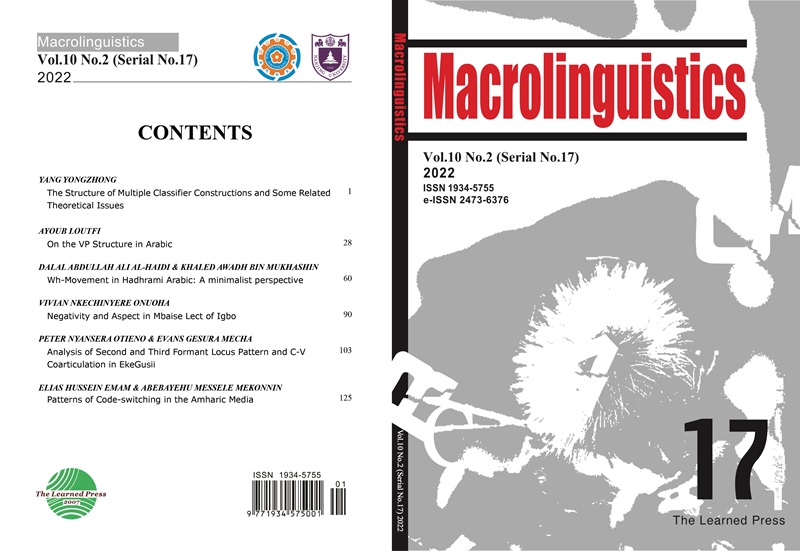南埃塞俄比亚-闪米特语的价码增加
引用次数: 0
摘要
本文重点研究了五种南埃塞俄比亚-闪米特语言(阿姆哈拉语、哈拉里语、Kɨstane语、Mşsqan语和Endşgaɲ语)中的增价手段的描述方法。选择这五种语言有两个原因。第一个原因是,对所有南埃塞俄比亚-闪米特语进行配价研究是不可能的。由于资源和时间有限,很难涵盖所有语言。第二个原因是,除了阿姆哈拉语,这些语言是众所周知的研究最少的语言。他们中的大多数人甚至缺乏足够的记录和描述。因此,本研究需要在各个分支中选择具有代表性的语言。因此,没有遵循明确的理论框架;数据分析仅以描述性视角为指导。这项研究的数据是通过启发咨询母语人士收集的。价一直被认为是一个语义和句法概念。作为一个语义概念,它被用来指代事件中的参与者;作为一个句法概念,它用于表示结构中自变量的数量。在埃塞俄比亚使用的南埃塞俄比亚闪米特语中,动词有不同类型的及物类:不及物、及物和双及物。除此之外,还有一些动词既可以不及物也可以及物。这些事实为南埃塞俄比亚-闪米特语的语法关系提供了明确的证据,对研究配价增加手段的概念至关重要。正如许多语言中的情况一样,南埃塞俄比亚闪米特语言拥有形态句法手段,通过这些手段可以调整动词的配价。这些形态句法过程的应用降低或增加了动词的化合价。本文考察了南部伦理闪米特语因果关系和应用关系中的增价手段。本文章由计算机程序翻译,如有差异,请以英文原文为准。
Valency Increasing in South Ethio-Semitic
The present paper focuses on a descriptive method of valency-increasing devices in five South Ethio-Semitic languages (Amharic, Harari, Kɨstane, Məsqan, and Endəgaɲ). The five languages were selected for two reasons. The first reason is that conducting a valency study on all South Ethio-Semitic languages would have been impossible. With limited resources and time, it will prove difficult to cover all languages. The second reason is that, except for Amharic, these languages are known for being the least studied. Most of them even lack sufficient recording and description. So this research needs to choose the representative language in each branch. As a result, no explicit theoretical framework is followed; data analysis is guided solely by a descriptive perspective. The study’s data was gathered by consulting native speakers via elicitation. Valency has been considered as both a semantic and syntactic notion. As a semantic notion, it is used to refer to the participants in an event; as a syntactic notion, it is used to indicate the number of arguments in a construction. There are different types of transitivity classes of verbs in the South Ethio-Semitic Language, which is spoken in Ethiopia: intransitive, transitive, and ditransitive. Apart from these, there are verbs that can be used both intransitively and transitively. The facts that provide clear evidence for grammatical relations in South Ethio-Semitic languages are crucial to the study of the concept of valency-increasing devices. As is the case in many languages, South Ethio-Semitic languages possess morphosyntactic means through which the valency of verbs can be adjusted. The application of these morphosyntactic processes decreases or increases the valency of verbs. This article looks at valency-increasing devices in Causative and Applicative South Ethio-Semitic languages.
求助全文
通过发布文献求助,成功后即可免费获取论文全文。
去求助
来源期刊
自引率
0.00%
发文量
83
审稿时长
20 weeks
期刊介绍:
Macrolinguistics (ISSN 1934-5755, e-ISSN 2473-6376) is an international academic journal which is specialized in research papers of non-Indo-European linguistics. It is published biannually by The Learned Press and funded by the Double First-Class Initiative of Nanjing University. It aims at contributing to the complementarity and interaction of linguistic research worldwide.

 求助内容:
求助内容: 应助结果提醒方式:
应助结果提醒方式:


